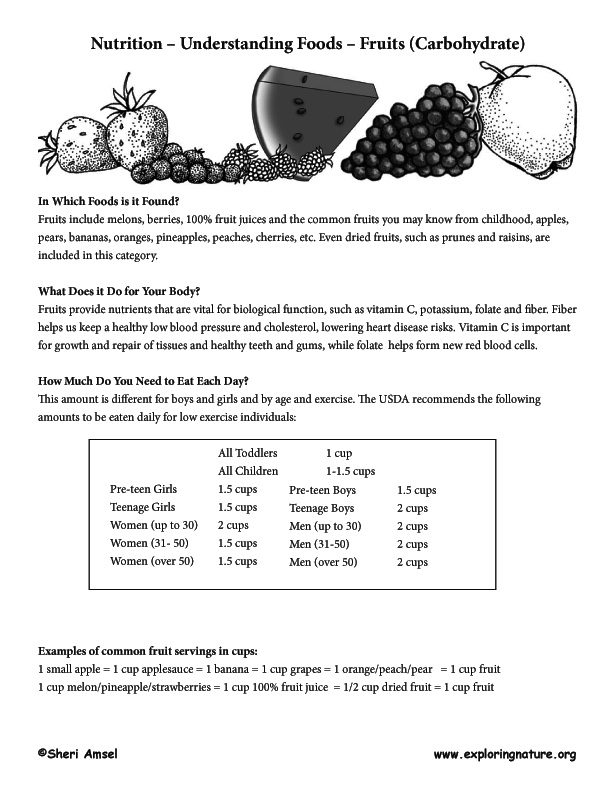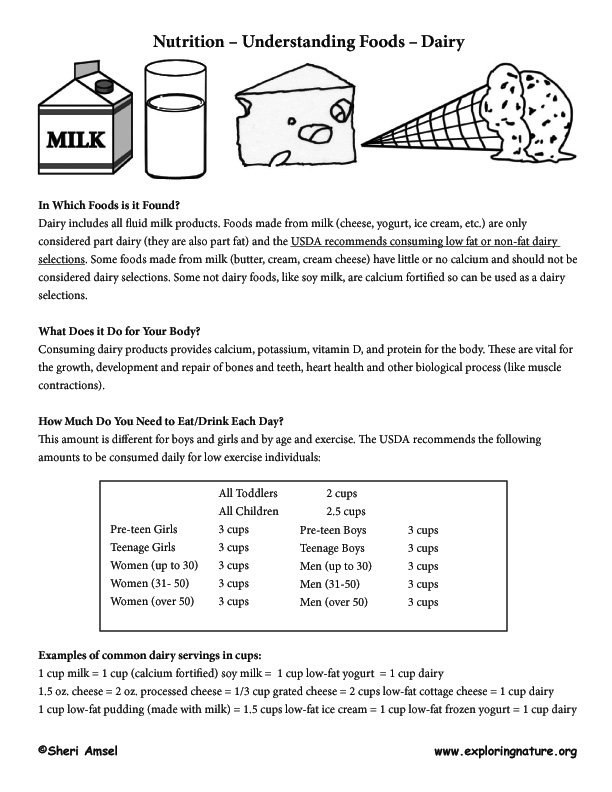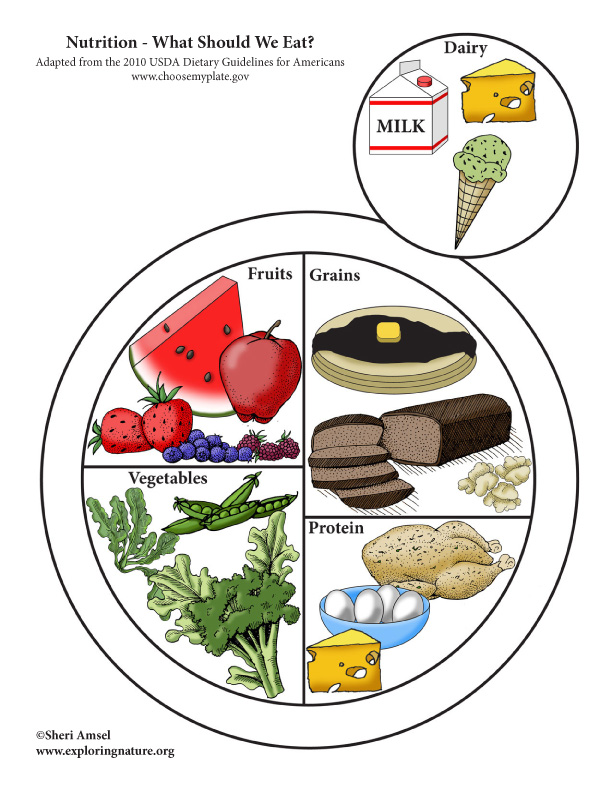

The processes and actions of the human body take energy. Eating the right foods, in the right amounts helps the body run effectively throughout ones life. This unit teaches about the different food groups broken down in a way that can help students develop healthy eating habits. We know that developed countries, like the United States, have been experiencing rising obesity and childhood diabetes. Educating about healhty eating habits is one way to combat this unhealthy trend. For more information about healthy eating, go to: https://www.choosemyplate.gov/MyPlate
Test your knowlege: Nutrition: The Foods We Need To Eat – Matching.
Other Activities: Color the Foods We Need To Eat, Draw the Foods We Need To Eat
Carbohydrates
In Which Foods is it Found?
Carbohydrates are found in fruits, vegetables and grains (such as breads, cereal, oatmeal, pasta, and anything made with flour - cookies, muffins, bagels, crackers, tortillas, etc.) Whole grains (whole wheat bread, brown rice, oatmeal) have a higher nutritional value than refined grains (white bread, white rice, baked goods made with white flour). Most refined grains are enriched with the B vitamins and iron (that were removed during refinement) added back in. The USDA recommends that at least 50% of all grains eaten be whole grains.
What Does it Do for Your Body?
Eating carbohydrates is important for providing the body’s energy – fuel for your muscles and brain functions. Eating carbohydrates is essential for critical thinking in school or at work and any kind of manual labor that coordinates thought and movement (everything).
How Much Do You Need to Eat Each Day?
About 50% of the food you eat each day should be carbohydrates. This amount is different for boys and girls and by age and exercise. The USDA recommends the following amounts to be eaten daily for low exercise individuals:
All Toddlers 3 ounces
All Children 5 ounces
Pre-teen Girls 5 ounces
Teenage Girls 6 ounces
Women (up to 30) 6 ounces
Women (to 50) 6 ounces
Women (over 50) 5 ounces
Pre-teen Boys 6 ounces
Teenage Boys 8 ounces
Men (up to 30) 8 ounces
Men (31-50) 7 ounces
Men (over 50) 6 ounces
Examples of common carbohydrate servings in ounces:
1 slice bread = 1 cup cereal flakes = 3 cups popcorn = 1/2 cup cooked rice or oatmeal = 1 ounce carbohydrate
1 cup cooked pasta = 1 cup cooked rice = 1 cup cooked oatmeal = 2 ounces carbohydrate
1 large bagel = 1 large 12” flour tortilla = 4 ounces carbohydrate
Grains (Carboydate)
In Which Foods is it Found?
Grains include wheat, rye, oats, rice, cornmeal, etc. They make up the following foods: flour, bread, pasta, cereal, tortillas, and baked goods of all kinds. Whole grains (whole wheat bread, brown rice, oatmeal) have a higher nutritional value than refined grains (white bread, white rice, baked goods made with white flour). Most refined grains are enriched with the B vitamins and iron (that were removed during refinement) added back in. The USDA recommends that at least 50% of all grains eaten be whole grains.
What Does it Do for Your Body?
Eating grain, which is a carbohydrate, is important for providing the body’s energy – fuel for your muscles and brain functions. This is an important food for critical thinking in school or at work and any kind of manual labor that coordinates thought and movement (everything).
How Much Do You Need to Eat Each Day?
About 50% of the food you eat each day should be grains, fruits and vegetables. This amount is different for boys and girls and by age and exercise. The USDA recommends the following amount of grains to be eaten daily for low exercise individuals:
All Toddlers 3 ounces
All Children 5 ounces
Pre-teen Girls 5 ounces
Teenage Girls 6 ounces
Women (up to 30) 6 ounces
Women (to 50) 6 ounces
Women (over 50) 5 ounces
Pre-teen Boys 6 ounces
Teenage Boys 8 ounces
Men (up to 30) 8 ounces
Men (31-50) 7 ounces
Men (over 50) 6 ounces
Examples of common grain servings in ounces:
1 slice bread = 1 cup cereal flakes = 3 cups popcorn = 1/2 cup cooked rice or oatmeal = 1 ounce carbohydrate
1 cup cooked pasta = 1 cup cooked rice = 1 cup cooked oatmeal = 2 ounces carbohydrate
1 large bagel = 1 large 12” flour tortilla = 4 ounces carbohydrate
Fruits (Carbohydrate)
In Which Foods is it Found?
Fruits include melons, berries, 100% fruit juices and the common fruits you may know from childhood, apples, pears, bananas, oranges, pineapples, peaches, cherries, etc. Even dried fruits, such as prunes and raisins, are included in this category.
What Does it Do for Your Body?
Fruits provide nutrients that are vital for biological function, such as vitamin C, potassium, folate and fiber. Fiber helps us keep a healthy low blood pressure and cholesterol, lowering heart disease risks. Vitamin C is important for growth and repair of tissues and healthy teeth and gums, while folate helps form new red blood cells.
How Much Do You Need to Eat Each Day?
This amount is different for boys and girls and by age and exercise. The USDA recommends the following amounts to be eaten daily for low exercise individuals:
All Toddlers 1 cup
All Children 1-1.5 cups
Pre-teen Girls 1.5 cups
Teenage Girls 1.5 cups
Women (up to 30) 2 cups
Women (31- 50) 1.5 cups
Women (over 50) 1.5 cups
Pre-teen Boys 1.5 cups
Teenage Boys 2 cups
Men (up to 30) 2 cups
Men (31-50) 2 cups
Men (over 50) 2 cups
Examples of common fruit servings in cups:
1 small apple = 1 cup applesauce = 1 banana = 1 cup grapes = 1 orange/peach/pear = 1 cup fruit
1 cup melon/pineapple/strawberries = 1 cup 100% fruit juice = 1/2 cup dried fruit = 1 cup fruit
Vegetables (Carbohydrate)
In Which Foods is it Found?
Vegetables include dark green vegetables (spinach, kale, broccoli), starchy vegetables (corn, peas, potatoes), red and orange vegetables (tomatoes, sweet peppers, carrots, squash, sweet potatoes), beans and peas, and other vegetables (cabbage, avocados, asparagus, green beans, zucchini, etc.).
What Does it Do for Your Body?
Vegetables provide nutrients that are vital for biological function, such as vitamin C and A, potassium, folate and fiber. Fiber helps us keep a healthy low blood pressure and cholesterol, lowering heart disease risks. Vitamin C is important for growth and repair of tissues and healthy teeth and gums, while folate helps form new red blood cells (and iron absorption). Vitamin A maintains healthy skin and eyes and helps prevent infections.
How Much Do You Need to Eat Each Day?
This amount is different for boys and girls and by age and exercise. The USDA recommends the following amounts to be eaten daily for low exercise individuals:
All Toddlers 1 cup
All Children 1.5 cups
Pre-teen Girls 2 cups
Teenage Girls 2.5 cups
Women (up to 30) 2.5 cups
Women (31- 50) 2.5 cups
Women (over 50) 2 cups
Pre-teen Boys 2.5 cups
Teenage Boys 3 cups
Men (up to 30) 3 cups
Men (31-50) 3 cups
Men (over 50) 2.5 cups
Examples of common vegetable servings in cups:
1 cup broccoli/cooked greens/carrots/tomatoes/squash/peppers/beans/peas/corn/potato/cabbage/cauliflower/ cucumbers/ green beans/zucchini = 1 cup vegetables
Proteins
In Which Foods is it Found?
Protein is found in red meat, poultry, fish, seafood, eggs, greek yogurt, nuts, seeds, beans and soy products (such as tofu).
What Does it Do for Your Body?
Eating protein is important because when protein is digested, it is broken down into amino acids, which are used by the body to fuel growth and repair of tissues (i.e. muscle, skin, organs, bones, etc.)
How Much Do You Need to Eat Each Day?
About 20% of the food you eat each day should be protein. For a teenager this is about 50 grams per day. This amount is different for boys and girls and by age and exercise. The USDA recommends the following amounts to be eaten daily for low exercise individuals:
All Toddlers 2 ounces
All Children 4 ounces
Pre-teen Girls 5 ounces
Teenage Girls 5.5 ounces
Women (up to 30) 5.5 ounces
Women (31- 50) 5 ounces
Women (over 50) 5 ounces
Pre-teen Boys 5 ounces
Teenage Boys 6.5 ounces
Men (up to 30) 6.5 ounces
Men (31-50) 6 ounces
Men (over 50) 5.5 ounces
Examples of common protein servings in ounces:
3 egg yolks = 1 ounce lean beef/pork/ham/cooked fish/chicken/turkey = 1 egg = 1 ounce protein
1 cup split pea/lentil/bean soup = 1 ounce nuts and seeds = 3 egg whites = 1 soy burger = 2 ounces protein
1 can tuna = 1 salmon steak = 1 trout = 4 ounces protein
How the food is prepared affects its nutritional value. Deep fat fried meats have a much higher saturated fat content than grilled, poached or baked. Also some cuts of meat are fattier than others as well. Processed meats and salted nuts have a much higher sodium content.
Dairy
In Which Foods is it Found?
Dairy includes all fluid milk products. Foods made from milk (cheese, yogurt, ice cream, etc.) are only considered part dairy (they are also part fat) and the USDA recommends consuming low fat or non-fat dairy selections. Some foods made from milk (butter, cream, cream cheese) have little or no calcium and should not be considered dairy selections. Some not dairy foods, like soy milk, are calcium fortified so can be used as a dairy selections.
What Does it Do for Your Body?
Consuming dairy products provides calcium, potassium, vitamin D, and protein for the body. These are vital for the growth, development and repair of bones and teeth, heart health and other biological process (like muscle contractions).
How Much Do You Need to Eat/Drink Each Day?
This amount is different for boys and girls and by age and exercise. The USDA recommends the following amounts to be consumed daily for low exercise individuals:
All Toddlers 2 cups
All Children 2.5 cups
Pre-teen Girls 3 cups
Teenage Girls 3 cups
Women (up to 30) 3 cups
Women (31- 50) 3 cups
Women (over 50) 3 cups
Pre-teen Boys 3 cups
Teenage Boys 3 cups
Men (up to 30) 3 cups
Men (31-50) 3 cups
Men (over 50) 3 cups
Examples of common dairy servings in cups:
1 cup milk = 1 cup (calcium fortified) soy milk = 1 cup low-fat yogurt = 1 cup dairy
1.5 oz. cheese = 2 oz. processed cheese = 1/3 cup grated cheese = 2 cups low-fat cottage cheese = 1 cup dairy
1 cup low-fat pudding (made with milk) = 1.5 cups low-fat ice cream = 1 cup low-fat frozen yogurt = 1 cup dairy
Fats (Oil)
In Which Foods is it Found?
Oils are fats that stay in liquid form at room temperature. Most are low in saturated fats. They are found in seeds, nuts, oils from foods like peanut butter, walnuts, almonds, fish, etc. Oils that are solid at room temperature (butter and margarine) are solid fats. They come from animal fats or hydrogenated vegetable oils. These saturated fats are found in processed foods, such as cookies, ice cream, crackers, chips, should be eaten very sparingly.
What Does it Do for Your Body?
Eating unsaturated fats is important for growth and development, energy and absorption of fat-soluble vitamins needed by the body (vitamin A, D, E, K).
How Much Do You Need to Eat Each Day?
About 30% of the food you eat each day should be fats. This amount is different for boys and girls and by age and exercise. The USDA recommends the following amounts to be eaten daily for low exercise individuals:
All Toddlers 3 teaspoons
All Children 4 teaspoons
Pre-teen Girls 5 teaspoons
Teenage Girls 5 teaspoons
Women (up to 30) 6 teaspoons
Women (31- 50) 5 teaspoons
Women (over 50) 5 teaspoons
Pre-teen Boys 5 teaspoons
Teenage Boys 6 teaspoons
Men (up to 30) 7 teaspoons
Men (31-50) 6 teaspoons
Men (over 50) 6 teaspoons
Examples of common oil servings in teaspoons:
1 tablespoon vegetable oil from canola/corn/olive/peanut/soybean/ safflower = 1 tablespoon oil = 120 calories
1 tablespoon mayonnaise/ margarine = 2.5 teaspoons oil = 100 calories
1 ounce roasted peanuts/cashews/almonds/sunflower seeds = 1 tablespoon oil = 165-180 calories
1/2 avocado = 1 tablespoon oil = 160 calories
2 tablespoons peanut butter = 4 teaspoons oil = 190 calories
2 tablespoons Italian dressing = 2 teaspoons oil = 85 calories
2 tablespoons thousand island dressing = 2.5 teaspoons oil = 120 calories
Vitamins
Calcium
In Which Foods is it Found?
Calcium is found in milk products (milk, yogurt, ice cream, cheese) and calcium fortified foods.
How Much Do You Need to Eat Each Day?
Growing teens should consume about 1,300 mg of calcium per day.
What Does it Do for Your Body?
Consuming calcium is important for bone development, muscle contraction, blood clotting and many other essential body functions.
Iron
In Which Foods is it Found?
Iron is found in red meat, green leafy vegetables (like spinach), and fortified foods (cereal, juices).
How Much Do You Need to Eat Each Day?
Growing teens should consume about 15 mg per day.
What Does it Do for Your Body?
Consuming iron is important for developing muscle and blood.
Calories
The calories you consume from the foods you eat provide energy for movement and bodily functions (such as digestion and breathing). Teenagers are growing and developing and need to consume between 2,000 - 3,000 calories a day, depending on the amount of physical activity they are doing.
When you research information you must cite the reference. Citing for websites is different from citing from books, magazines and periodicals. The style of citing shown here is from the MLA Style Citations (Modern Language Association).
When citing a WEBSITE the general format is as follows.
Author Last Name, First Name(s). "Title: Subtitle of Part of Web Page, if appropriate." Title: Subtitle: Section of Page if appropriate. Sponsoring/Publishing Agency, If Given. Additional significant descriptive information. Date of Electronic Publication or other Date, such as Last Updated. Day Month Year of access < URL >.
Amsel, Sheri. "Nutrition - The Foods We Need To Eat" Exploring Nature Educational Resource ©2005-2024. March 25, 2024
< http://www.exploringnature.org/db/view/5159 >









